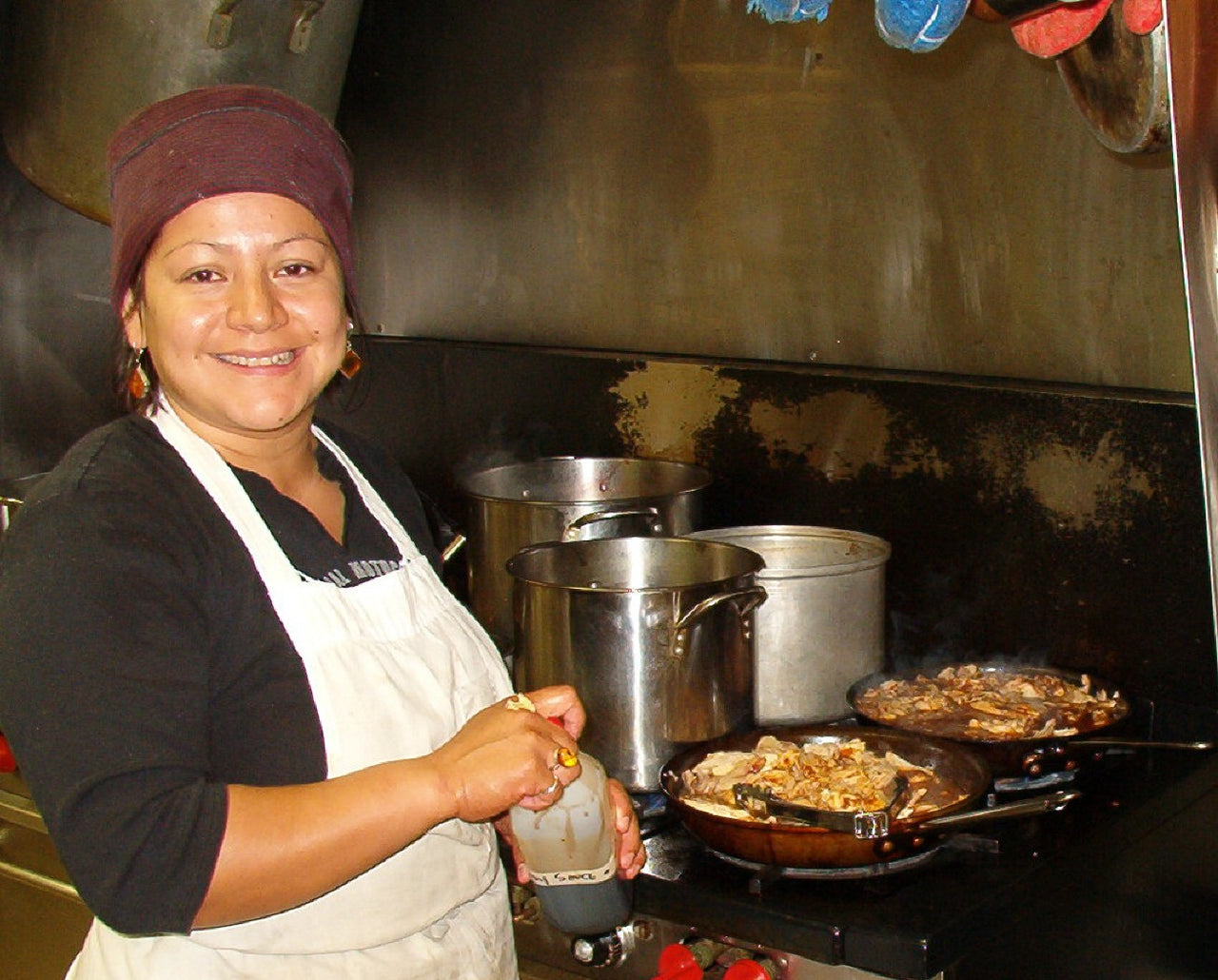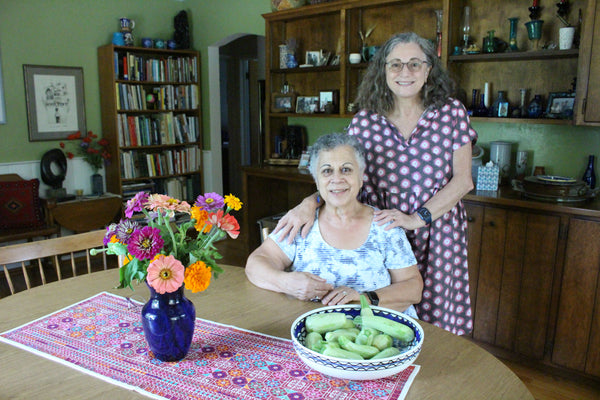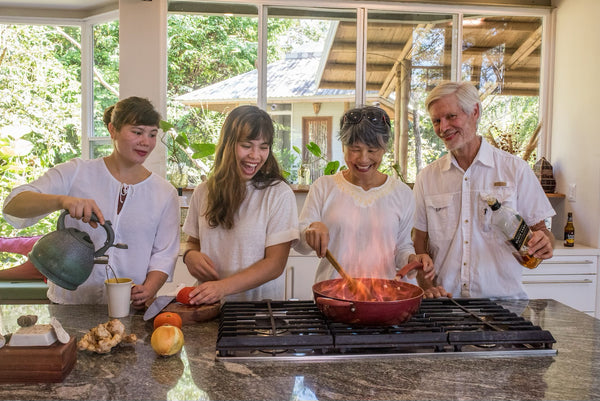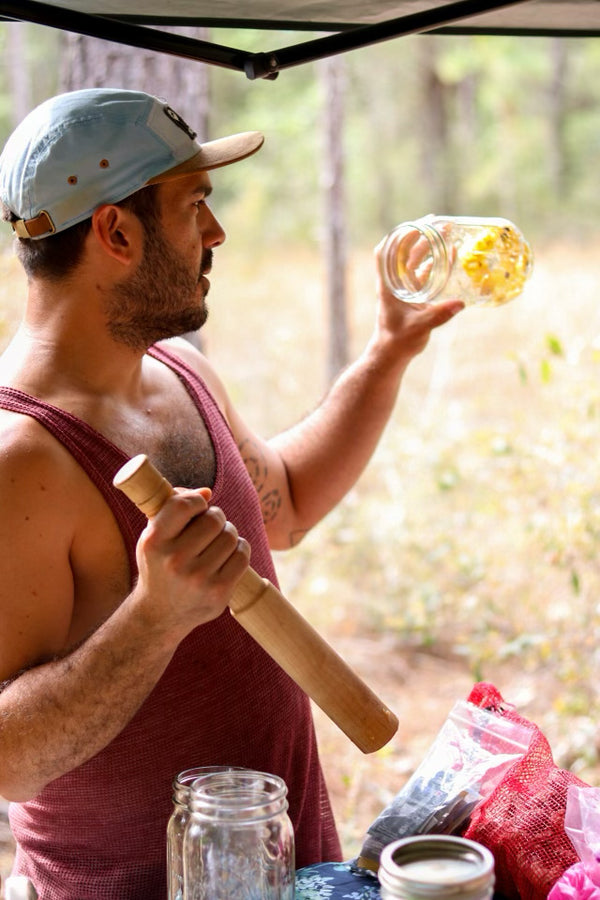Sylvia Nolasco-Rivers of Pilar’s Tamales has been an absolute pil(l)ar in Ann Arbor for the past 20 years. Not only has she been serving delicious tamales, pupusas, and fried plantains at her family restaurant - since then, Sylvia has worked hard to fundraise for a variety of humanitarian causes, both locally and internationally. Sylvia founded Pilar’s Foundation in 2019 out of a determination to provide aid to refugees. In fact, the weekend before our interview, Sylvia led the organization in its first charitable event as an official 501(c)(3) non-profit, raising funds for Afghan refugees in Ann Arbor via a drive-thru tamale sale at Zion Lutheran Church. Sylvia is no stranger to knowing what it’s like to be a refugee in a strange country, with only a small suitcase and a few belongings. She and her family, refugees from the Salvadoran Civil War, came to the United States in the 1980s seeking sanctuary from the war and all its atrocities. Food and community have played an integral role in Sylvia’s journey, from small child in Central America, all the way to successful entrepreneur and passionate philanthropist serving up everything she does with love and care.
Roots in El Salvador
As I sit in 19 Drips, a small café to the right of Pilar’s, I sip my latte, scrolling through the various hits that come up on my phone when I google Sylvia Nolasco-Rivers: Former refugee, Ann Arbor small business owner pays it forward with nonprofit, Pilar’s Tamales to host fundraiser benefiting Afghan refugees, Sylvia Nolasco-Rivers supports people in need with tamales, tenderness, and time, Sylvia Nolasco-Rivers Reprioritizes: A smaller tamale shop will leave more time for her nonprofit - the list goes on and on. Despite having lived in Ann Arbor my whole life, I’d somehow never met Sylvia but had heard about her through many friends (“you’ll love her and you’ll love her food!”) and was both excited and nervous to meet her. “Who is this woman?” I wondered, taking a slow sip of my hot drink.
The café was empty other than me and the server at the front desk, so when Sylvia came in I immediately knew it was her. I was also aware that I would have known it was her even if there had been 50 other people in that café. Sylvia may be small, but she has a personality that fills a room. Her first order of business was checking in with the worker behind the desk, to whom she was obviously like family (“How are you, my love?”), and after genuinely listening to his reply, her sunshiney demeanor transferred focus to my little couch in the back corner of the store. “Grace! That must be you. It is so nice to meet you, darling!” She marched over to me and gave me a bear hug as if we had known each other for years. And, in this way, our conversation began.

Pictured: Sylvia, with her sunny smile, taking orders at Pilar's.
Sylvia was born in the early 1970s in San Jacinto, a little town in San Salvador, the capital of El Salvador. She grew up knowing that something was wrong in the country she called home, but “as a kid, whatever situation you grow up in, it’s normal - you don’t see anything particularly bad or strange about it,” she told me. 1979 marked the beginning of the Salvadoran Civil War, in which over 75,000 people were killed, along with 8,000 disappearances. Nine out of ten Salvadoran families lost at least one family member during this time. It was a time of horrible and frequent human rights violations. Kidnapping, torture, and murder of innocent civilians was a common practice. In the early 80s, Sylvia’s family was very politically involved against the oppression of the El Salvadoran government. They were revolutionaries, organizing other young people to put their lives on the line for the chance to call themselves free in their own country.
But in 1981, her family’s efforts came to an abrupt and sad end. After a massacre at Sylvia’s grandmother’s house, her family knew that it was no longer safe for them. “The way the government dealt with families like ours was that it would wipe out our entire family,” Sylvia told me matter-of-factly. “And so, one evening, I’ll never forget… my mother came in and said ‘pack one change of clothes; we need to leave now,’ and me and my sister packed one little jean backpack each and then we headed north. I didn’t question anything - that’s what you do when you’re 9 years old. You follow your parents. You don’t question it.”
Sylvia and her family were aided by friends of the Sanctuary Movement, a social movement in the 1980s that grew out of the need to protect those fleeing the atrocities of the Central American Wars. They made their way first to Mexico City, then Phoenix, Arizona, and finally, Eugene, Oregon, where they would be the first Salvadoran refugees received there by a Quaker sanctuary. Sylvia remembers hiking for 6 hours at a time in the mountains of Arizona, helped along the way by guides who would tell them when they could walk, and when they had to stay still. They were camouflaged the entire time, and wore blankets over their heads.
In 1983, her family arrived in Eugene, Oregon, where they remained for the next ten years. With the love and support of their community, they began to have a more normal life. They went to school, made friends, and started to adapt. All the while, her family was telling their story, spreading the word about the crisis in El Salvador, hoping that people in the States would write to the government to help the Salvadorans and to cease its funding of the government’s military. “People should not have to flee their homes fearing for their lives, having done nothing wrong. My parents did not take our move lightly,” reflects Sylvia, “it’s very traumatic to leave your home without any warning, to have to adapt to the society and culture of a foreign land. It’s like you’re a tree that’s been growing for years and you’ve gotten everything you need - plenty of water, good soil, and sun - but when it’s no longer safe, and the tree has to be transplanted elsewhere, you just have to hope that the roots take.”
But people (and trees) are often very resilient, and we frequently do learn to adapt, “with love and support,” concludes Sylvia.
Surviving and Thriving on Ancestral Foods
In El Salvador, Sylvia was continually surrounded by food. Her mother, grandmother, and aunts were all great cooks, though their meals were usually quite simple. Meat, cheese, and dairy were only for people who could afford it. Sylvia grew up on a mainly vegan diet, though it wasn’t by choice - it was simply what was available. Grains, beans, rice, squash, corn, peppers, and green leafy vegetables were the staples of their family meals. There were lots of fermented salads, and lots of veggies sitting around in jars, preserved with vinegar. Once in a while, they would have eggs, but most days it was variations of beans and rice - in soups, in casamiento (rice and beans), refried with plantains, in tortillas, or with avocado. “As kids, we never asked for more,” Sylvia told me. “We were content with what we were given, and we took time to enjoy it.”
Sylvia remembered her Aunt Pilar and her grandmother always had a garden. Their gardens were simple, with “little squashes and things growing around.” What Sylvia had the greatest affinity for were her grandmother’s little lime trees. One of her favorite things to do after school was pick a lime off of the tree, peel it, and sprinkle a little bit of salt and a dash of hot sauce on top. She’d sit under the little lime tree, savoring her favorite treat, letting the hot, beaming sun warm her skin. She laughs, telling me that one day, she remembers getting really sleepy and her head falling back against the thorns in the tree - “That woke me up!” No lasting damage was done, thankfully, but from then on she was always a little more cautious about her afterschool pursuits underneath the lime tree.
Sylvia didn’t grow up cooking things like tamales and pupusas with her family, as they are very labor intensive foods. Instead, there were “the tamale lady” and “the pupusa lady” down the street. If they wanted either of these specialty items, Sylvia’s mother would toss her some coins and tell her to go down to the pupusa and tamale ladies stand and get a dozen of each.
In Eugene Oregon, there were no pupusa or tamale ladies. Sylvia said that’s when her mother learned to cook these things, not only as a way of feeding her family the foods of their ancestors, but also as a way to support their family. Neither of her parents spoke English, and both were undocumented, so it took some time for them to get a regular job. Until then, they would have Sylvia walk around their neighborhood, knock on the people’s doors, and say “my mom is making tamales, would you like to buy some?” I thought about this Salvadoran version of Girl Scout cookie sales and giggled, and Sylvia added with a laugh “Nobody said no - How can you say no to a 9 year old girl? Even if you have no idea what tamales are?”

Pictured: Making tamales at Pilar's.
Sylvia’s family utilized their knowledge of their ancestral food as means of survival in more ways than one. “In El Salvador,” Sylvia said, “you weren’t required to have all the things you need here to have a little business. [No licenses, permits, certifications, etcetera.] You could set up shop just about anywhere. If you have a little mango tree, you can just put some mangoes on a stand and sell them. It’s that simple.” Back in El Salvador, at Auntie Pilar’s, the kids were all sent out with baskets full of veggies from the garden, instructed to sell whatever they could to the neighbors. Sylvia, being the little businesswoman she was, remembers asking her aunt “If I sell everything in my basket before everyone else, can I get an extra penny?” She looks back on those times fondly, and knows now that these experiences eventually led her to where she is at present; a successful restaurateur and skilled chef.
Bringing a Taste of El Salvador to Ann Arbor
While Sylvia and her immediate family lived in Oregon during the Salvadoran Civil War, Sylvia’s Aunt Pilar and her children relocated to Ann Arbor, where they were hosted by the Quaker house on Hill Street. Every summer, Sylvia and her family would visit them in Ann Arbor for a few weeks. Sylvia fell in love with Ann Arbor, and when she graduated from high school, she moved there herself. She started working at Espresso Royale, and would walk through the Diag every day after work. She remembers a particularly moving moment, a moment that would lead to her making more permanent roots in Ann Arbor. “It was so simple,” she says, her dark brown eyes shining with emotion, “I was walking through the Diag on a beautiful, sunny day. I was 19 years old. And I remember a strong feeling that I was safe for the first time in my life. And I just stood there, crying. When you grow up, in any situation of violence, and you’re no longer in that situation, once you’re out of that feeling of oppression, it’s liberating - ‘I’m alive!’” Her voice cracks, and she continues her narrative, tears streaming silently down her face.

Pictured: Sylvia and her son, Gabe in Pilar's kitchen.
From that moment onwards, she knew that Ann Arbor would be her new home. Within a year, she had talked her family into moving from Eugene to Ann Arbor, and they’ve all been here ever since. Sylvia worked at several restaurants, baking bread, serving sandwiches, waitressing, prepping veggies, and more. She fell in love with working at restaurants “because of the people connection,” she states. Sylvia loves people. Her conversations as a little girl in El Salvador were with her elders, listening to their stories. She asked so many questions that a few members of her family thought her annoying at times, but this trait of endless curiosity has served her well as she endeavored to eventually open her own restaurant and create her own non-profit.
Tamales and Pupusas
I was so engrossed in Sylvia’s life story that I very nearly forgot to ask more questions about her ancestral foods, the same foods that continue to feed so many hungry Ann Arborites to this day. I asked her more about pupusas and tamales - “How did you decide what your menu would look like once you opened Pilar’s?” I asked, thinking back to the pupusa and tamale ladies back in El Salvador. From the experience Sylvia and her mother both had cooking and selling tamales all those years back in Eugene, combined with Sylvia’s expertise of working with a variety of different foods in a number of settings, they decided that tamales and pupusas had to be staples of their menu.
Pupusas are the national dish of El Salvador. The name pupusa comes from the Pipil-Nahuatl word, pupushahua. The Pipil are an indigenous Mesoamerican people living in Western El Salvador, and their creation of the pupusa is known to pre-date Spanish colonization. A pupusa is a soft, handmade corn tortilla most commonly stuffed with cheese, chicharrón (pulled pork), refried beans, and/or loroco (a flower bud native to Central America that tastes somewhat like artichoke).
Sylvia told me that they started off with just two tamales on their menu, both with a different story of how they came to be. The first tamale, called the Christmas Tamale, was one that they grew up with. It contains chicken or pork, capers, green olives, a slice of potato, and sometimes green pepper. The capers and olives were expensive when Sylvia was a child in El Salvador, because they didn’t grow there and had to be imported. So it was also called Tamale Especial, or Special Tamale, because it was a treat when they could afford it. The second tamale was inspired by Sylvia’s time in Oregon. In the early 80s, there was a little restaurant that carried a tempeh burger, and Sylvia claimed that for her, it was love at first bite. So when she opened Pilar’s, the second tamale on the menu was the Tempeh Tamale, a tasty fusion of different cuisines.
Sylvia and her mother and family were the main help at first, and they made do with what they could afford. “We would take turns stirring our beautiful broth and corn masa in this big giant pot with a big giant wooden spoon,” Sylvia pantomimes stirring with great effort and a hunched back. It was a lot of work, but they did what they had to do, until they could afford a secondhand mixer, which does the work for them. “We didn’t have a perfect recipe either - we went batch by batch. ‘That batch was good, let’s make it better,’” was their constant, patient mantra.
Food as Teacher
Sylvia wrapped up her narrative by sharing a handful of stories about how food itself can sometimes be our teacher. “There is an energy in everything,” Sylvia states. Food has power; the power to bring us together, and the power to teach us, if only we will listen.
One such instance was the story of how she learned to make the most buttery, tender tamales in town. “Sometimes, tamales get a bad rap because the corn can sometimes be kinda dry,” Sylvia explains. Once, she discovered too late that she’d added too much chicken broth to the masa, to the point where they couldn’t wrap the tamales because it was too runny. Instead of discarding the cake-batter-like broth, Sylvia suggested they wait to see what happens if they keep it in the fridge overnight. Lo and behold, the extra broth ended up being absorbed into the corn, and in the morning, it became the most beautiful texture and taste - exactly what Sylvia had dreamed of. Thus, from her tamales, Sylvia learned patience.
Another such story involves horchata, a delicious, sweet drink popular in El Salvador, containing rice, cinnamon, morro seeds (the seeds that give Salvadoran horchata its unique flavor), sesame seeds, brown sugar, and vanilla. Sylvia remembers an instance of making horchata with her son Issac, telling him that he was to be in charge of the part in the process where you use a really fine cheesecloth material, waiting for the mixture to filter through while you whisk it (adding a little water and stirring, adding a little and stirring, etc.). She said she remembers Isaac carrying on like this for 20 minutes, looking at the small amount he had produced, and gasping “Mom! That’s it? After all that work?” To which Sylvia replied knowingly, “It’s a labor of love, my son.” In a world where sugar has become more common and available than healthy, fresh produce, we forget the time it takes to make something sweet by hand, with love, instead of with machines in big food processing plants. And so, from horchata, we can learn to labor for love - to make something sweet for someone when all you want out of it is to make them really happy.



Pictured: Making horchata at Pilar's is a labor of love.
Sylvia started learning the beneficial effects of laboring for love when she was a little girl in El Salvador. She remembers her mother cooking the most beautiful, simple little meals. “Maybe in the fridge there was only a tomato, three-quarters of a green pepper, and half an onion. But to this day, I can remember my mother chopping everything so patiently, sautéing it with a little canola oil, chopping the tomato and making a little bit of sauce… and it was so tasty. It was because of the time she was taking, because of the love and care she put into that food. It doesn’t matter what you have, so long as you prepare it with love.”
I couldn’t agree more.
By Grace Pernecky
___________________________________________________To donate to Pilar’s Foundation, click here.
To order delicious food from Pilar’s Tamales, click here.




